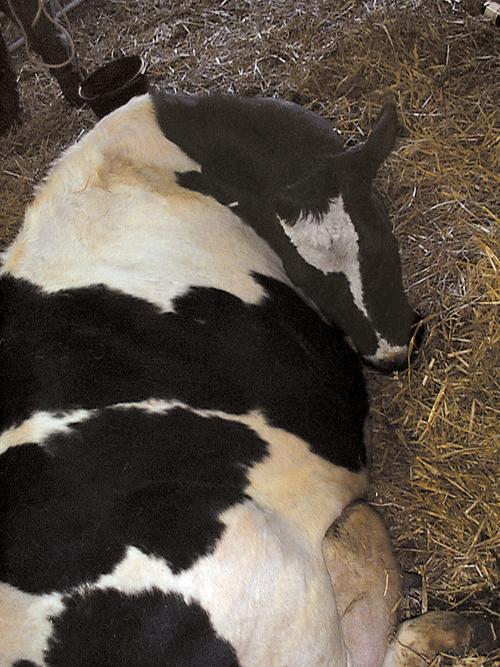Difference between revisions of "Cattle Medicine Q&A 11"
| (6 intermediate revisions by 3 users not shown) | |||
| Line 1: | Line 1: | ||
| − | {{Template:Manson}} | + | {{Template:Manson Scott}} |
[[Image:Cattle Medicine 11.jpg|centre|500px]] | [[Image:Cattle Medicine 11.jpg|centre|500px]] | ||
| Line 5: | Line 5: | ||
<br /> | <br /> | ||
| − | '''A 6-year-old Holstein cow, which calved 36 hr earlier, is presented in sternal recumbency, profoundly depressed, dehydrated, afebrile (38.5°C,101.3°F | + | '''A 6-year-old Holstein cow, which calved 36 hr earlier, is presented in sternal recumbency, profoundly depressed, dehydrated, afebrile (38.5°C,101.3°F), with toxic mucous membranes, an elevated heart rate of 96 beats per minute, and an increased respiratory rate (34 breaths per minute). The udder is soft but a pale, serum-like, secretion can be drawn from one quarter.''' |
<br /> | <br /> | ||
| Line 20: | Line 20: | ||
*botulism <br><br> | *botulism <br><br> | ||
It may prove difficult to rule out the possible contribution of hypocalcaemia and many clinicians would elect to administer 400 mL of 40% calcium borogluconate slowly by the intravenous route while monitoring the heart rate. | It may prove difficult to rule out the possible contribution of hypocalcaemia and many clinicians would elect to administer 400 mL of 40% calcium borogluconate slowly by the intravenous route while monitoring the heart rate. | ||
| − | |l1= | + | |l1=:Category:Mastitis |
|q2=What treatments would you administer? | |q2=What treatments would you administer? | ||
|a2= | |a2= | ||
Treatment of endotoxic shock (coliform mastitis) includes intravenous injection of a NSAID, repeated 12 hr later. <br><br> | Treatment of endotoxic shock (coliform mastitis) includes intravenous injection of a NSAID, repeated 12 hr later. <br><br> | ||
| − | Hypertonic saline (7.2%) infusion at a dose rate of 5mL/kg (3 L for 600 kg cow) over 5–7 minutes is achieved through a 13-gauge 10cm jugular catheter. <br><br> | + | Hypertonic saline (7.2%) infusion at a dose rate of 5mL/kg (3 L for 600 kg cow) over 5–7 minutes is achieved through a 13-gauge<sup>1</sup> 10cm jugular catheter. <br><br> |
Access to 30–60 L of warm water, which may contain electrolytes, must be provided although not all cows drink; some clinicians recommend stomach tubing volumes up to 30–40 L. <br><br> | Access to 30–60 L of warm water, which may contain electrolytes, must be provided although not all cows drink; some clinicians recommend stomach tubing volumes up to 30–40 L. <br><br> | ||
This cow made a full recovery. Mastitis caused by ''Streptococcus uberis'' can present with many of the clinical features of coliform mastitis and it may prove prudent to administer a broad-spectrum antibiotic both parenterally and by intramammary infusion. | This cow made a full recovery. Mastitis caused by ''Streptococcus uberis'' can present with many of the clinical features of coliform mastitis and it may prove prudent to administer a broad-spectrum antibiotic both parenterally and by intramammary infusion. | ||
| − | |l2= | + | |l2=:Category:Mastitis |
|q3=What control measures could be adopted? | |q3=What control measures could be adopted? | ||
|a3= | |a3= | ||
| Line 35: | Line 35: | ||
*Teat sealants should be used at drying-off. | *Teat sealants should be used at drying-off. | ||
*Use of J5 ''Escherichia coli'' core antigen vaccine could be considered. | *Use of J5 ''Escherichia coli'' core antigen vaccine could be considered. | ||
| − | |l3= | + | |l3=:Category:Mastitis |
</FlashCard> | </FlashCard> | ||
| + | |||
| + | <br style="clear:both;" /> | ||
| + | {| align="left" width="100%" cellpadding="5" style="background-color:#FFFFFF; border:3px solid #ccc;" | ||
| + | |- | ||
| + | | align="center" | [[File:Wikivet logo.png|40px|WikiVetlogo]] | ||
| + | | align="left" | <p>Comments by Nick Lyons MA VetMB CertCHP MRCVS</p> | ||
| + | <p>1. Minor point, only catheters 12 or 14 gauge are available in the UK. </p> | ||
| + | |} | ||
| + | <br><br><br> | ||
| + | |||
| + | <!---- | ||
| + | {{Comments | ||
| + | |by = Nick Lyons MA VetMB CertCHP MRCVS | ||
| + | }}----> | ||
| + | |||
{{#tag:imagemap|Image:Next Question.png{{!}}center{{!}}200px | {{#tag:imagemap|Image:Next Question.png{{!}}center{{!}}200px | ||
Latest revision as of 15:10, 19 March 2012
| This question was provided by Manson Publishing as part of the OVAL Project. See more Cattle questions |
A 6-year-old Holstein cow, which calved 36 hr earlier, is presented in sternal recumbency, profoundly depressed, dehydrated, afebrile (38.5°C,101.3°F), with toxic mucous membranes, an elevated heart rate of 96 beats per minute, and an increased respiratory rate (34 breaths per minute). The udder is soft but a pale, serum-like, secretion can be drawn from one quarter.
| Question | Answer | Article | |
| Which diseases would you consider? (Most likely first.) | The most likely conditions to consider include:
It may prove difficult to rule out the possible contribution of hypocalcaemia and many clinicians would elect to administer 400 mL of 40% calcium borogluconate slowly by the intravenous route while monitoring the heart rate. |
Link to Article | |
| What treatments would you administer? | Treatment of endotoxic shock (coliform mastitis) includes intravenous injection of a NSAID, repeated 12 hr later. |
Link to Article | |
| What control measures could be adopted? |
|
Link to Article | |
Comments by Nick Lyons MA VetMB CertCHP MRCVS 1. Minor point, only catheters 12 or 14 gauge are available in the UK. |
